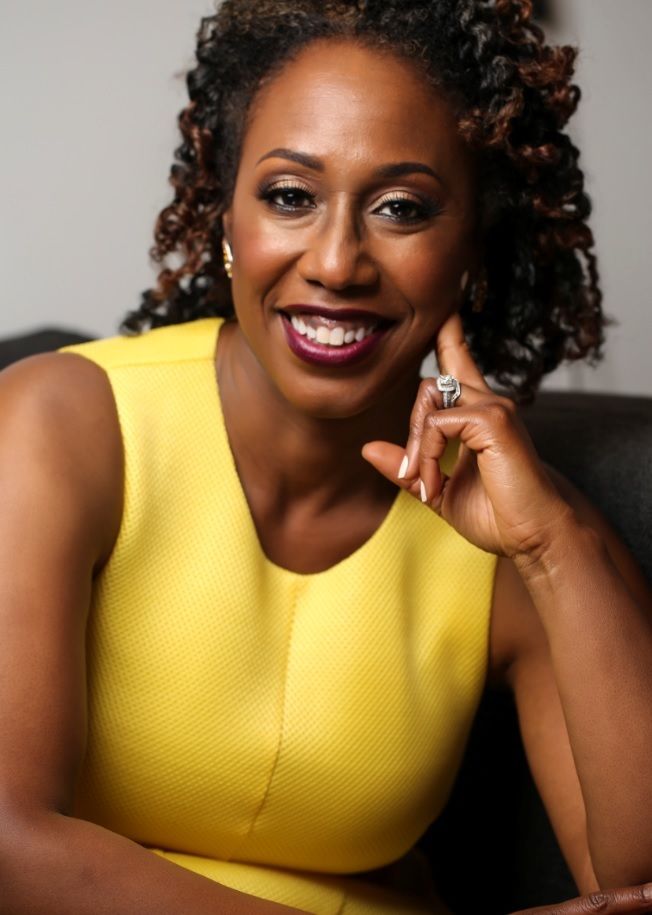
Michele Tapp Roseman
When Michele Tapp Roseman spoke to me, her voice was kind and her determination flowed through each and every word. The conversation was initially about hair, but it became about BEING. Michele has published her book, Hairlooms, written to inspire black women about hair and beauty. She has interviewed some of the greats, including but not limited to Dr. Maya Angelou and actress Kim Coles. Hairlooms became more than just a book, but an open conversation, a movement about beauty, equality and the true essence of one’s curly hair.

Hairlooms: The Book- By Michele Tapp Roseman
I asked Michele to share about Hairlooms, how women can begin to love their natural hair and how to break down hair boundaries. It’s time to de-tangle the myths about curly hair and re-define what is truly beautiful. In Michele Tapp Roseman’s words:
The concept for Hairlooms materialized after numerous, random encounters with women who asked about my natural afro and proceeded to tell me stories about their hair. Some of these impromptu conversations centered on product and hairstyle fails. Others pinpointed the best way to wear a *do* to work. These women were old, young, permed, and natural. Over time, I realized that I and other African American women were wrestling with our own stories about hair and beauty. The root of the tension stemmed from words we spoke and others had spoken about our hair and beauty. While different in some ways, their journeys were a lot like my own.
I wanted to create a platform for Black women – and those who connect with us – to begin to write a new narrative about our hair and beauty. I wanted to heighten Black women’s awareness about our unconscious and conscious use of derogatory words – such as knotty or bad when describing our hair and beauty. We can’t readily stop sectors of society from defining us and depicting us in particular ways. We can, however, control over the words that come from our mouths.
It was truly my desire to help empower Black with the tools to wisely check, challenge, and choose the words we use about ourselves wisely.
The best way to describe how negative words impact a Black woman’s esteem is with an analogy. I love burning candles. The image of the flickering flame is soothing, and the aroma that fills the air is a great stress-buster for me. Over the holiday, I purchased a candle that had a topper. What was the purpose of the topper? Once placed over the burning candle, the absence of oxygen snatched the flame from the once-burning wick. The topper was responsible for removing the once-brilliant flame and enticing aroma that belonged to the candle. So it is with negative words in the lives of Black women. The flame of creativity, self-love, and respect stop flickering when comments and barbs are thrown our way. The capacity for brilliance is still there, but much work is needed to move beyond the “topper” of negativity. Thankfully with work and intentionality, we can repurpose the same tool. Affirming words can actually to stoke the flame of our true inner and outer beauty.
Given the breadth and scope of the material I cover in Hairlooms, the stories, content, exercises, and resources will likely be useful for different groups of people. First, I believe that all Black women will benefit from the book. Whether we wear weaves, perms, or natural styles the stories will resonate. Whether we work in the board room or classroom. If we live in the US, UK, or Africa, some part of this book will touch our lives and possibly give us the release to embrace ourselves in a new, life-giving way.
While Hairlooms addresses issues that directly impact Black women, I intentionally wanted to open the door for other groups who have questions about, or aren’t familiar with, the array of challenges many of us face. Recent spikes in interracial marriages and transracial adoptions signal the need for answers to basic questions they may have, such as: “How do I handle a child’s hair that is not like my own?” This book also bridges the information gap for men who are connected with us. We all know that touching our hair at the wrong time or making a humorous remark about our looks can be grounds for a civil war. In their defense, a lot of times the men in our worlds—Black and White—are honestly not aware of the deep-rooted self-acceptance issues we carry about our hair and beauty. Left unchecked, we may find ourselves in relationships with emotional knots that are difficult to untangle.
I’ve lived and walked through the words and exercises in Hairlooms. The material is not just something I wrote, but something I still use to empower me today. I was touched by the words of one reader/endorser, natural hair blogger Glamazini:
“Reading through each chapter of Hairlooms was soothing and familiar. I found myself sliding effortlessly through each chapter like a wide-toothed comb through conditioner-covered tresses.”
Interviewing every contributor was wonderful! I have to say that I was surprised by the remarks from the dads with whom I spoke. They weren’t always able to put their hands on the issue, but each understood that a woman’s and girl’s self-perception is really shaped by words. I was amused at their accounts of braiding and realizing the power of the color pink and dolls! My heart was warmed as I realized that these men are going to impact their corners of the world and potentially bring clarity to other men. What can I say about the ladies? Everyone is a powerhouse and I truly admire the rawness with which they share their insights about their own beauty. Some interviews moved me to tears and others caused me to laugh with gut-busting squeals. Each story is poignant. Each story is precious. Each story is real.
Hairlooms will help women rewrite their stories by challenging them to examine words used by themselves and others. It’s been said that a picture paints a thousand words. While true, I know that one word can destroy the most beautiful picture. Alternatively, as readers work through the exercise and practice saying kind words, the building blocks for transformation are forming. I always say that change doesn’t come over night, but it will come over time. With practice and intentional insertions of new phrases, our personal stories will reflect a greater appreciation for God’s unique design in our lives.
We gravitate toward the familiar. Our “go to” hairstyles, food choices, and outfits are usually those we’ve experienced at some point in our lives. In comparison, I know that Hairlooms will resonate with people across the globe because the stories and content shared are familiar to many. We all know what it’s like to call our own beauty into question because of infertility, sexual assault, or terminal illness. Who doesn’t know the sting of an ill-spoken word or the blissful lift from a timely spoken compliment? Geographical boundaries, social strata collapses, and the playing field are leveled as readers come to grips with this truth: positive words about hair and beauty have the power to change anyone!
